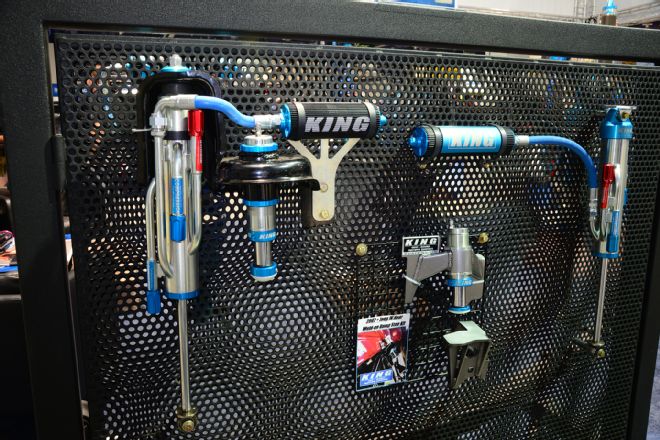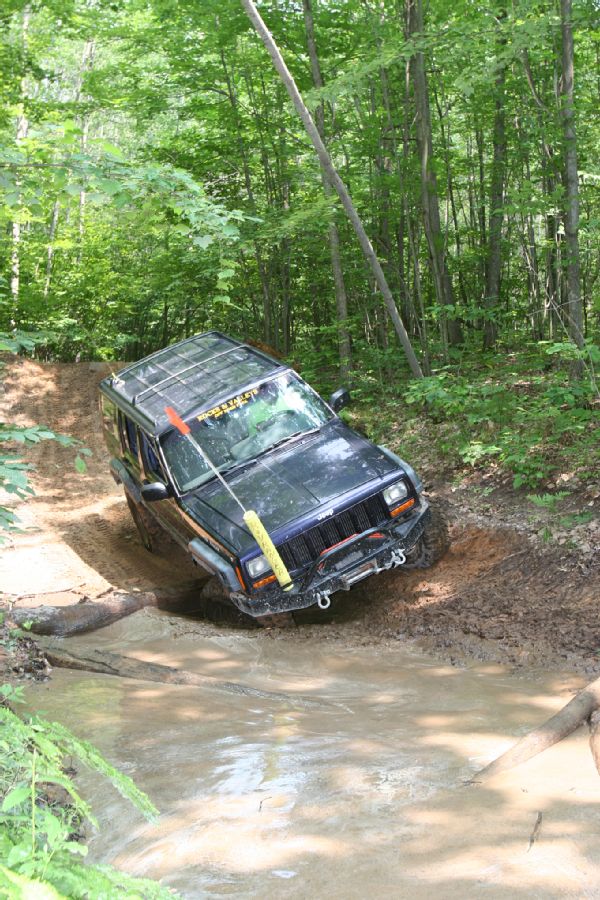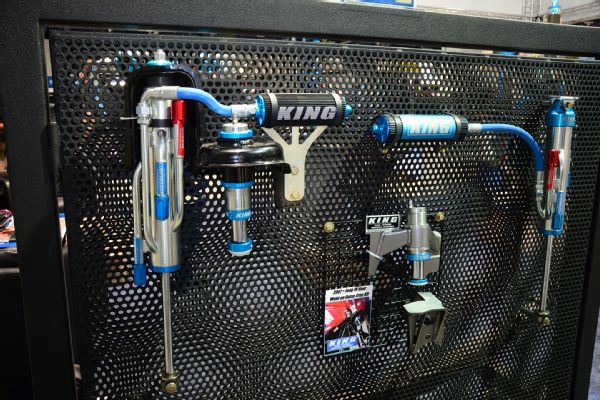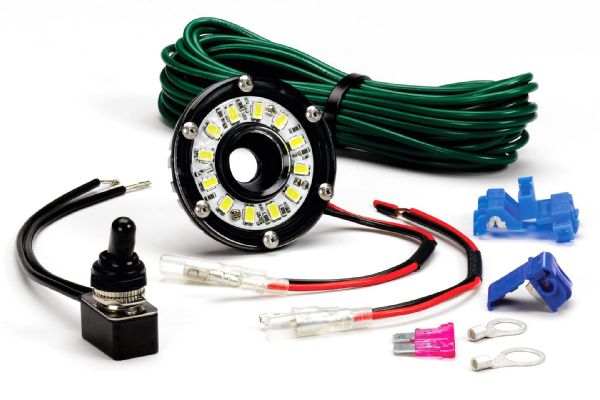
 John Cappa
Former Editor, Four Wheeler
Photographers:
Jp Archives
John Cappa
Former Editor, Four Wheeler
Photographers:
Jp Archives

Manual-Shift AW4
I'm thinking about building a Cherokee Sport with a stroked 4.0L, and I want an automatic transmission with manual shift capabilities. What would be the top three choices for this?
Bill Starnes
Via email
I’ll assume you want a later-model XJ Cherokee with the common AW4 four-speed automatic transmission, since it’s the most common and reliable. Fortunately, the AW4 is an electronically shifted transmission, so you can forgo the traditional route of installing a manual valve body as you would with other common automatic transmissions. You have a couple of options if you want a manually shifted AW4. Transgo (transgo.com) offers a shift kit for the Jeep AW4 that provides shorter and firmer shifts. It’s not exactly a full-manual conversion, but it does give you the ability to keep the transmission in First gear when shifted to the L (First-Second) gear setting. The kit doesn’t require transmission removal for installation.
Radesigns (radesignsproducts.com) offers the Rail II shift controller. This electronic unit interfaces with the wiring of the AW4 via three wires. It gives you the ability to manually select First through Fourth gear. The factory shifter can be retained, but a Winters-style gate shifter is also available. Be careful, though, as manually shifting and lugging a gear could cause a lot of transmission heat buildup, which could lead to transmission failure. Seriously consider adding a transmission temperature gauge if you go this route.
Montana Fab (montanafab.com) used to offer an electronic shifting kit that allowed the AW4 to be shifted manually. However, the product is no longer listed on the website. You might try calling the company to see if it is still available.
Since the AW4 is electronically shifted, there have been some clever individuals that have simply wired in a few switches and lights in the harness to trick the transmission into manually shifting how they want. If you have very little wiring experience, this is a risky route that you should likely avoid. If not, you can search online for multiple how-to write-ups.
You could also swap in a completely different and more durable transmission with a manual valve body. This is certainly the most complex and expensive route, but options include the venerable GM TH350, TH400, and 700R4. All of these transmissions are much more heavy-duty than the AW4, so if monster tires or abusive off-road use are in the plans, it might be a good option. Advance Adapters (advanceadapters.com) offers the necessary adapters to mate the GM transmissions to your 4.0L and NV231 transfer case. The Chrysler TorqueFlite 999 and 727 are also heavy-duty three-speed automatic options and can be converted with a full-manual valve body.
If you really want a manually shifting transmission, you could consider swapping in a real manual transmission. The Jeep AX15 and NV3550 would be fairly straightforward swaps. However, you would need a manual transmission ECM for your engine to work properly.

Smoothing Washboard Roads
I own a ’07 Wrangler Unlimited JK. It has 103,000 no-hassle, no-problem miles on it. About 20,000 of these miles are off-road Baja Mexico miles. It has a winch, lift, BFG tires, and so on. The JK has been the perfect adventure rig for me, but I haven’t figured out the right setup for all the washboard "roads" I encounter in Mexico. I’d love to see a Jp article with some solutions or suggestions. I’m tired of beating my brains out!
Bob Rief
Cardiff-by-the-Sea, CA
The incessant shaking and rattling caused by long stretches of washboard roads can be absolutely maddening. It’s nearly impossible to find the right speed to negate the effects that the numerous small bumps have on your Jeep. Sometimes simply driving faster can smooth out the chattering. However, more speed has its own downside. There are a few easy solutions and some expensive ones, too. The most effective way to decrease the rattling effect of the poorly maintained washboard roads is to air your tires down. Deflating your tires to 10-15 psi (depending on tire size and wheel design) can make a huge difference. Lower tire air pressure allows the tires to more easily conform to defects in the road surface. You might need to experiment with different tire pressures for best results. Don’t go too low though or sharp rocks could damage your tires. If the roads are littered with larger rocks, you may not want to lower the tire pressure as much as you would on a road with a crushed gravel surface. The taller the tire sidewall you have, the smoother your Jeep will ride over the unkempt roads. Needless to say, something like 20-inch wheels on 31-inch tires will never ride smooth regardless of how much you air down. Also, don’t forget to keep a source of compressed air onboard for when you need to refill the tires.
The right shocks can also make a big difference in these conditions. In most cases, aftermarket shocks feature stiffer valving than the factory shocks. However, even though the stock shocks may initially ride better than firmer aftermarket shocks, they will quickly begin to fade from heat, decreasing performance. If you are serious about getting the best performance possible, consider installing adjustable bypass shocks. Adjustable bypass shocks can be tuned to be soft over small bumps, and firm up when the suspension cycles near the end of its range over larger bumps and whoops. For washboard roads, you’ll likely want to completely loosen the bypass valves so the shock piston can freely move oil through the passages. Companies such as ARB (arbusa.com), King (kingshocks.com), Rubicon Express (rubiconexpress.com), and Sway-A-Way (swayaway.com) all offer bolt-on adjustable bypass shocks for the ’07-current Jeep Wrangler and Wrangler Unlimited.
Four-Popper TJ
I've been a Jeep fan for almost 13 years now and am on my third Jeep. I've recently subscribed to Jp and can't get enough of it. You guys do a great job. I just have a few tech questions for you. I have a ’97 Jeep Wrangler TJ with the 2.5L four-cylinder engine and an automatic transmission. I remember reading in the "Shrink Ray TJ" series where you replaced the front coils in your TJ with coils from a ZJ. I have recently acquired a pair of ZJ coils from a local auto wrecker and plan on putting them in my TJ. Do you think my factory shocks will still do their job with the added lift? Will I need to change anything else along with the ZJ coils? I plan on running 31x10.50R15 tires, so nothing crazy for right now.
Also, I can't seem to find what transmission my Jeep has. Do you know what kind it likely has or where I would be able to find that information? Thank you for taking the time to read my email. Any help would be appreciated. Keep up the good work. I love reading Jp magazine!
Eric Musetti
Via email
Swapping the ZJ coils to the front of your TJ should get you about 2 1/2-3 inches of lift over your stock coil springs. The exact amount of lift will depend on the weight of your Jeep. A hardtop, aftermarket front bumper, winch, dual batteries, and so on can add a significant amount of weight to your Jeep, which can alter the finished ride height. In most cases, the factory shocks will come up a little short with the taller coils, unless you don’t plan on flexing the suspension much and only drive on-road, although I would still recommend a longer pair of shocks, bumpstop extensions, and possibly an adjustable track bar.
The ’97-’02 2.5L Jeep Wrangler came standard with an AX-5 five-speed manual transmission. It was available with an optional Chrysler TorqueFlite 904 three-speed automatic, also known as the 30RH. It’s a fairly stout automatic transmission for its size. A lift and bigger tires make the Wrangler four-popper/auto combo feel like a bit of a pig. Fuel economy suffers as well. It’s extremely important to match up the proper axle gear ratio to your tire size of choice. With the 31-inch rolling stock, I’d prefer to have at least 4.10 to 4.56 gears in the axles. However, your axles likely have 3.73 gears, so it’s not really worth the expense to make the swap until you get into larger tire sizes. And if that’s the case, you’ll likely want to address the weaknesses of the Dana 35 rear axle at that point.
Buick 225 Injecting
I am rebuilding a ’68 Jeepster convertible with a 225ci V-6 engine. In the “High Five” article in the Dec. ’15 issue, John Briggs has a V-6 in his ’67 Jeep CJ-5. He upgraded the engine with a DUI ignition system and a Retrotek Powerjection throttle body fuel injection system. I would like to know what I would have to do to install these parts on my V-6. The ignition system is not that much of a problem, but the throttle body fuel injection system I’m not sure. Would I need to install an electric fuel pump, removing the mechanical fuel pump? What about the throttle body? Would I need to get a new intake manifold along with the throttle body? If so, where can I get these parts? Would the original return fuel line work with the throttle body and electric fuel pump? What other problems might I run into with this upgrade? Any helpful hints would be nice.
Robert Dunkel
Westerville, OH
Performance Distributors (performancedistributors.com) offers a bolt-in Davis Unified ignition (DUI) for the Buick 225ci V-6. You’ll also need a set of HEI-style plug wires to complete the installation. Performance Distributors has these as well. The DUI is a great upgrade for any engine with an anemic ignition. Each distributor is hand-built and installs with a single wire hookup. It’s a very simple, reliable, and effective ignition upgrade, especially for older vehicles with poorly maintained points ignition systems.
The Professional Products (professional-products.com) Powerjecton III self-learning EFI system is designed to fit on a four-barrel square-bore intake manifold. The stock Buick 225 intake manifold is designed for a two-barrel Rochester carburetor, so it won’t bolt up. However, companies such as Edelbrock (edelbrock.com) and Offenhauser (offyparts.com) offer new high-performance square-bore aluminum intake manifolds for the Buick 225 V-6.
You will need to remove the factory mechanical fuel pump and block off the fuel pump port on the side of the engine block. The new EFI system will require the installation of an electric fuel pump. Some of the Powerjection kits include an inline electric fuel pump. You can also install a pump in your fuel tank, but this will require a bit more work than the inline pump. In most cases you will need to run a new 5/16-inch fuel return line to the fuel tank or filler tube. The OE fuel-return line on your Jeep may be too small. If it is smaller than 5/16-inch, don’t use it because too small a line can cause your engine to run too rich and very poorly. It’s not difficult to build a coupler with a return line fitting that you can splice into the fuel filler tube. Some fuel tanks may have a useable return line fitting, while other fuel tanks can be drilled and tapped for a fuel return fitting.

Shedding Light
I’m hoping that, with your technical common sense, you can shed a little light on the confusing KC HiLites Cyclone specifications. The older lights were 3.4 watts, and the new lights are 5.0 watts. Yet, it was explained to me that the output remained at 400 Lumens. It doesn’t make sense to me. I could believe that the lights went from 3.4 watts and 400 Lumens to 5.0 watts and 1,100 Lumens with more efficient LEDs. Any chance you can get the straight tech scoop? I’m thinking about using two as backup lights on my Jeep. Any thoughts?
Bill Adelmann
Temecula, CA
The KC HiLites (kchilites.com) Cyclone LED lights are really useful compact auxiliary lights that can be mounted to flat surfaces. They would make great ultra-bright interior lights, rock lights, auxiliary reverse lights, and so on. There are several different mounting brackets that are also available. I think there must have been some miscommunication. Generally, given a specific voltage, in this case 12 V, a higher-wattage LED light will produce more Lumens. Unfortunately, a higher-wattage light draws more amps, making it less efficient. The good news is that LED lights are far more efficient than traditional incandescent bulbs. Keep in mind a typical headlight draws about 4 to 5 amps. The older 3.4-watt Cyclone light would pull slightly more than 1/4 amp. The current 5-watt Cyclone light will pull slightly less than 1/2 amp. Either way, the difference is negligible and not enough to be concerned about. Run the 5-watt lights and enjoy the extra Lumens.
Weighty Discussion
Upon seeing "Lightweight Wrangler, First All-Aluminum Jeep JK Spotted!" on the cover of the Jan. ’16 issue, I whipped through the pages straight to page 54 with bated breath. I have become quite fond of using aluminum in my Jeep projects over the last decade. I even welded up a CJ-3B hood a few years back and have considered some of Aqualu's other offerings.
However, very conspicuously absent from Jake Headlee's article were any mention of actual weights. The stock JK steel panels appear to be something close to 20 gauge (0.0375 inches thick). Using that steel thickness with Aqualu's 5/32-inch aluminum and the relative densities of mild steel (7.85 g/cc) and aluminum (2.70 g/cc), it would appear that the Aqualu tub could be as much as 1.4 times more weighty than a similarly stripped stock JK tub, the unknowns of the extent of double panels and other reinforcements notwithstanding. So, is this just a very expensive case of halitosis or is the Aqualu tub actually lighter?
John Goering
Bozeman, MT
Unfortunately, at the time the feature was shot, the owner, Jason Robson of Modern Classic Enterprises (modernclassicenterprises.com), didn’t know the actual weight of the Jeep. It wasn’t until later that it was rolled onto the scales. A complete stock steel-bodied JK Wrangler Unlimited Rubicon has a curb weight of around 4,300 pounds depending on options. The Modern Classic Enterprises Jeep with the Aqualu (aqualu.com) aluminum body tub weighs in at 4,800 pounds loaded and ready to hit the trail, which is impressive when you consider that most built JK Unlimited Jeeps on 37-inch tires tip the scales trail ready at 5,500 pounds with some besting a porky 7,000 pounds.
Now, is the Aqualu body actually lighter than the stock steel body? It’s not quite as easy as throwing the two bodies on the scale, and it’s a more complex question than simply figuring the density differences between the steel and aluminum that is used for each body. We’d also have to figure in the factory seam glue, undercoating, double-wall panels, and more when making a comparison. Since the rollcage/B-pillar is welded to the factory steel body, do we include that too? Also, since the Aqualu body is made from more durable 5/32-inch (0.156) thick aluminum, should we include the weight of any body armor you might need to add to a factory steel Wrangler body? Do you give the aluminum body extra credit for being rust resistant? If you include the factory rollcage of the steel body, the Aqualu aluminum body is said to be lighter. However, I was unable to get the exact weight of the factory steel body. The stripped Aqualu aluminum JK Unlimited body tub weighs in at 381 pounds. Needless to say, you can only save so much weight via the body because it simply doesn’t weight that much, regardless of material selection.
Ultimately, I really don’t think it’s a fair apples-to-apples comparison because there is so much more to consider than just the weight of the two bodies. Most people would not use an Aqualu aluminum body for a daily driver. Using a body like this would generally require that you eliminate the safety and convenience features that a factory four-door JK would have. This would include airbags, traction control, stability control, ABS brakes, stereo and navigation system, original heater and air conditioner, sound deadening, carpet, hardtop, and so on. If you enjoy these factory conveniences, you probably don’t want a Jeep like this, so arguing over the weight difference of the two bodies is pointless. The aluminum body has too many advantages that you can’t overlook, even if it isn’t a direct bolt-in replacement. The Modern Classic Enterprises Jeep features several elements that make it lighter overall. The Aqualu aluminum body is only one of these elements.